关于初中英语时态再复习
初中英语八种时态归纳复习 详解
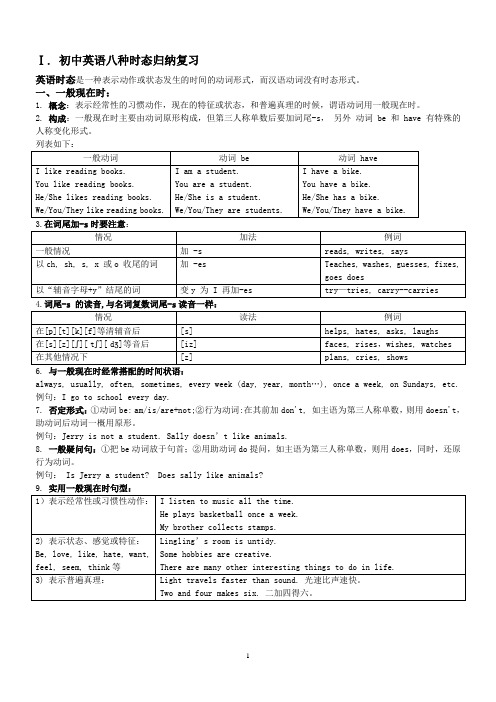
Ⅰ. 初中英语八种时态归纳复习英语时态是一种表示动作或状态发生的时间的动词形式,而汉语动词没有时态形式。
一、一般现在时:1. 概念:表示经常性的习惯动作,现在的特征或状态,和普遍真理的时候,谓语动词用一般现在时。
2. 构成:一般现在时主要由动词原形构成,但第三人称单数后要加词尾-s,另外动词be 和 have 有特殊的人称变化形式。
6. 与一般现在时经常搭配的时间状语:always, usually, often, sometimes, every week (day, year, month…), once a week, on Sundays, etc.例句:I go to school every day.7. 否定形式:①动词be: am/is/are+not;②行为动词:在其前加don't, 如主语为第三人称单数,则用doesn't,助动词后动词一概用原形。
例句:Jerry is not a student. Sally doesn’t like animals.8. 一般疑问句:①把be动词放于句首;②用助动词do提问,如主语为第三人称单数,则用does,同时,还原行为动词。
例句: Is Jerry a student? Does sally like animals?9. 实用一般现在时句型:二、一般过去时1.概念:过去某个时间里发生的动作或状态,现在已经不再继续;过去习惯性、经常性的动作、行为。
2.构成:一般过去时由动词的过去式表示,1) 动词be有 was, were 两个过去式,was 用于第一、第三人称, were 用于第二人称和第一、二、三人称的复数形式。
动词表。
读音规则:month…), in 1989, just now, at the age of 5, one day, long long ago, once upon a time, etc.4.否定形式:①was/were+not;②在行为动词前加助动词didn't,助动词后加动词原形。
英语总复习专题:八种时态总复习

例如:He said that he would finish his work before 9 o’clock.
他说他会在九点之前完成工作。
2)“was/were going to+动词原形”所表示的过去将来
时,表示过去曾经打算做某事。
在疑问句中,主语为第一人称时(I和we)时,常 用助动词shall。 例如: Shall we go to the zoo tomorrow? 我们明天去动物园,好吗?
结构二: 主语+be going to +动词原形+其它 I am going to buy a car next year.
2. 一般将来时的用法 : 结构一的用法: 1)表示将来某个时间要发生的动作或存在的状态, 例如:I'll meet you at the school gate tomorrow morning. 2)表示将来经常或反复发生的动作。 例如:I’ll come and see you every Saturday next year. 3)表示说话人对于将来的看法、假设和推测。 例如:I think she’ll go back home for supper.
例如: He often goes swimming in summer.
他夏天经常游泳。
I usually leave home for school at 7 every morning.每天早上我七点离开家去学校。
2)表示现在的状态。 例如: The boy is twelve. 这男孩十二岁。 3)表示主语具备的性格、特征和能力等。 例如: My sister is always ready to help others . 我妹妹总是乐于助人。 Ann writes good English but does not speak well. 安英语写得不错,讲的可不行。
初中英语八大时态语态总复习时态讲解

初中英语八大时态语态总复习时态讲解Middle School XXX: Present Simple XXXThe present simple tense is used to XXX。
XXX。
or XXX。
It is often used with adverbs of frequency such as sometimes。
often。
usually。
and always。
Time XXX。
everyday/week/month/year。
at noon/night。
on Monday/Tuesday。
etc。
can also be used with the present simple tense。
For example:Bruce usually walks to school.We have two P.E classes every week.The present simple tense can also be used to XXX:She is always ready to help others.He is 13 years old.It can also be used to express facts。
objective truths。
or XXX:The sun rises in the east and sets in the west every day.When there is a will。
there is a way.XXX basic XXX:1) Affirmative sentence:Subject + verb (base form) + othersSubject (third person singular) + verb-s + othersFor example:They live in China.XXX.2) Negative sentence:Subject + don't + verb (base form) + othersSubject (third person singular) + doesn't + verb (base form) + othersFor example:They don't live in China.XXX.3) Interrogative sentence:Do + subject + verb (base form) + others?Does + subject (third person singular) + verb (base form) + others?For example:Do they live in China?Does he like eating apples?当主语是第三人称单数时,谓语动词要用第三人称的单数形式。
2024年中考英语复习专题初中英语语法六大时态总结
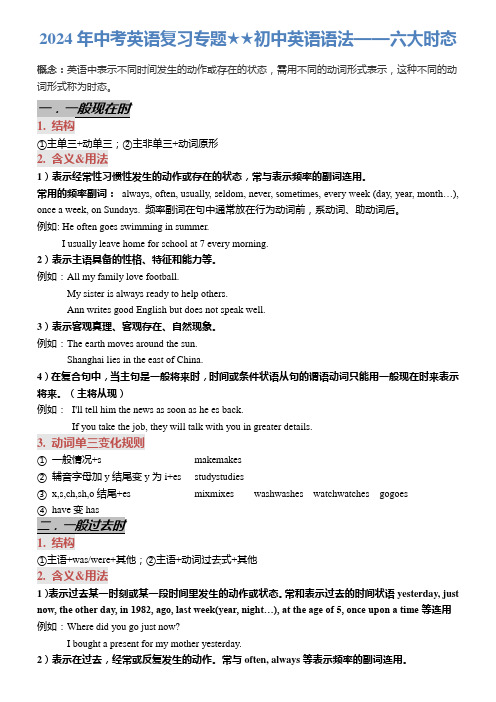
2024年中考英语复习专题★★初中英语语法——六大时态概念:英语中表示不同时间发生的动作或存在的状态,需用不同的动词形式表示,这种不同的动词形式称为时态。
一.一般现在时1. 结构①主单三+动单三;②主非单三+动词原形2. 含义&用法1)表示经常性习惯性发生的动作或存在的状态,常与表示频率的副词连用。
常用的频率副词:always, often, usually, seldom, never, sometimes, every week (day, year, month…), once a week, on Sundays. 频率副词在句中通常放在行为动词前,系动词、助动词后。
例如: He often goes swimming in summer.I usually leave home for school at 7 every morning.2)表示主语具备的性格、特征和能力等。
例如:All my family love football.My sister is always ready to help others.Ann writes good English but does not speak well.3)表示客观真理、客观存在、自然现象。
例如:The earth moves around the sun.Shanghai lies in the east of China.4)在复合句中,当主句是一般将来时,时间或条件状语从句的谓语动词只能用一般现在时来表示将来。
(主将从现)例如:I'll tell him the news as soon as he es back.If you take the job, they will talk with you in greater details.3. 动词单三变化规则①一般情况+s makemakes②辅音字母加y结尾变y为i+es studystudies③x,s,ch,sh,o结尾+es mixmixes washwashes watchwatches gogoes④have变has二.一般过去时1. 结构①主语+was/were+其他;②主语+动词过去式+其他2. 含义&用法1)表示过去某一时刻或某一段时间里发生的动作或状态。
初中英语八种时态归纳复习(one)

一、一般现在时(一)定义表示经常或习惯性的动作,或存在的状态,还表示主语具备的性格和能力及客观真理。
列:l get up at 6:30 in the morning she is at home (二)构成主要用动词原形表示,当主语是第三人称单数时,在动词词尾加s/es。
(三)句型1、肯定句:主语+谓语+其他。
She reads English everday2、否定句:主语+don’t/doesn’t+谓语+其他。
He doesn’t get up at 6:30 in the morning3、一般疑问句:do/does+主语+V原形+其他?Do you like English? Yes, l do./no,l don’t4、特殊疑问句:特殊疑问词+ do/does+主语+V 原形+其他?What time do you get up every morning?Where does your father work?(四)用法1、表示经常或习惯性的动作,或存在的状态,带与表示频率的时间壮语如:often,sometimes,usually,always,everyday/year,month…)once/twice a week(month,year ect)seldom,on Sundays等连用。
l leave home for school at seven every morning.2、表示客观真理,科学事实、格言警句。
The sun rises in the east.日出东方The earth goes around the sun。
地求饶着太阳转。
3、当主句的谓语动词是一般将来时,那么时间或条件状语从句的谓语动词只能用一般现在时表示将来要发现的动作。
l’ll tell him the news when he comes back.他回来时,我将告诉他这个消息。
4、仅为了描述状态、性质、特征、能力等等。
初中英语五个时态专题练习和答案(复习可用)
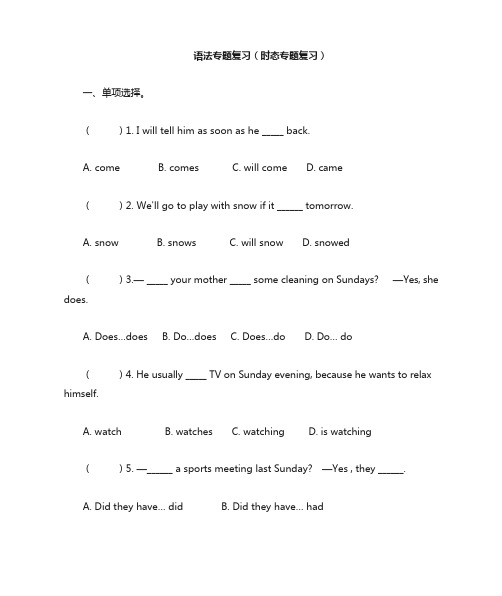
A. snow
B. snows
C. will snow D. snowed
( does.
)3.— _____ your mother _____ some cleaning on Sundays? —Yes, she
A. Does…does B. Do…does C. Does…do D. Do… do
( )11. You _____ me waiting for two hours. I _____ for you since five.
A. kept…waited
B. have kept…waited
C. kept…have waited D. have kept…have waited
( )12. —Where _____John _____?
6. We_________ (have) a good time in the Summer Palace last Sunday.
7. If it _________________ (not rain) tomorrow, we'll have a football match.
8. Don't forget _____________ (close) the window when you leave the room.
A. got to
B. reached C. arrive in D. reach
( )10. She ______ to school yesterday because of the strong wind and heavy rain.
A. goes B. went C. doesn’t go D. didn’t go
初中英语六种时态归纳复习(精编word)

初中英语六种时态归纳复习时态是英语学习中一个至关重要的内容一、一般现在时:概念:经常、反复发生的动作或行为及现在的某种状况。
时间状语:always, usually, often, sometimes, every week (day, year, month…), once a week, on Sundays, etc.基本结构:①be动词;②行为动词否定形式:①am/is/are+not;②此时态的谓语动词若为行为动词,则在其前加don't,如主语为第三人称单数,则用doesn't,同时还原行为动词。
一般疑问句:①把be动词放于句首;②用助动词do提问,如主语为第三人称单数,则用does,同时,还原行为动词。
二、一般过去时:概念:过去某个时间里发生的动作或状态;过去习惯性、经常性的动作、行为。
时间状语:ago, yesterday, the day before yesterday, last week(year, night, month…), in 1989, just now, at the age of 5, one day, long long ago, once upon a time, etc.基本结构:①be动词;②行为动词否定形式:①was/were+not;②在行为动词前加didn't,同时还原行为动词。
一般疑问句:①was或were放于句首;②用助动词do的过去式did 提问,同时还原行为动词。
三、一般将来时:概念:表示将要发生的动作或存在的状态及打算、计划或准备做某事。
时间状语:tomorrow, next da y(week, month, year…),soon, in a few minutes, by…,the day after tomorrow, etc.基本结构:①am/is/are/going to + do;②will/shall + do.否定形式:①was/were + not; ②在行为动词前加didn't,同时还原行为动词。
初中高中英语八大时态语态
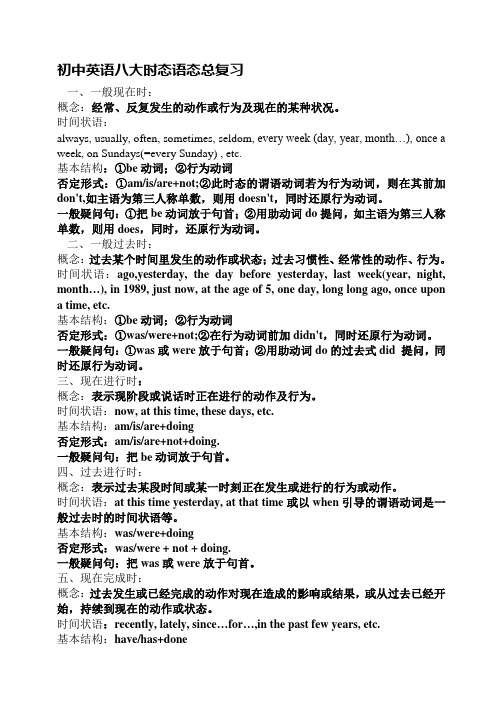
初中英语八大时态语态总复习一、一般现在时:概念:经常、反复发生的动作或行为及现在的某种状况。
时间状语:always, usually, often, sometimes, seldom, every week (day, year, month…), once a week, on Sundays(=every Sunday) , etc.基本结构:①be动词;②行为动词否定形式:①am/is/are+not;②此时态的谓语动词若为行为动词,则在其前加don't,如主语为第三人称单数,则用doesn't,同时还原行为动词。
一般疑问句:①把be动词放于句首;②用助动词do提问,如主语为第三人称单数,则用does,同时,还原行为动词。
二、一般过去时:概念:过去某个时间里发生的动作或状态;过去习惯性、经常性的动作、行为。
时间状语:ago,yesterday, the day before yesterday, last week(year, night, month…), in 1989, just now, at the age of 5, one day, long long ago, once upon a time, etc.基本结构:①be动词;②行为动词否定形式:①was/were+not;②在行为动词前加didn't,同时还原行为动词。
一般疑问句:①was或were放于句首;②用助动词do的过去式did 提问,同时还原行为动词。
三、现在进行时:概念:表示现阶段或说话时正在进行的动作及行为。
时间状语:now, at this time, these days, etc.基本结构:am/is/are+doing否定形式:am/is/are+not+doing.一般疑问句:把be动词放于句首。
四、过去进行时:概念:表示过去某段时间或某一时刻正在发生或进行的行为或动作。
时间状语:at this time yesterday, at that time或以when引导的谓语动词是一般过去时的时间状语等。
初中英语各种时态复习及练习题

初中英语时态复习及练习题一、一般现在时1. 定义:表示通常性、规律性、习惯性的状态或者动作(有时间规律发生的事件)的一种时间状态,或.表示主语具备的性格、能力和特征。
(1、现在的状态。
2、经常或习惯性动作。
3、主语所具备的性格和能力。
4、客观真理。
)2.标志:often(经常),usually(通常),sometimes(有时),always(总是),never(从不),on Sundays (在星期天), every day/month/year(每一天/月/年)3.结构:(1)主语+连系动词be(am/is/are)+名词/形容词/数词/介词短语/副词等做表语表状态(包括There be +n. There is a rabbit.)练习: 1.I______(be) a student. My name_____(be) Tom.2. Where _____(be) my shoes? They___(be) here.3.Who ____(be) the girl with long straight hair? I think she ___(be) Kate.4. You and I ___(not be) in Class Six.5.___(be) there a supermarket on the Fifth Avenue? Yes, there_____(be).6. ____ her parent tall? No, he____.(2)主语(非第三人称单数)+行为动词原形+其他(用助动词do 帮助构成否定句、一般疑问句和特殊疑问)(3)主语(第三人称单数)+行为动词的第三人称单数+其他(用助动词does 帮助构成否定句、一般疑问句和特殊疑问句)行为动词第三人称单数加-s的形式:1.直接加s2. 辅音+y结尾,变y为i加es: study-studies3.以s,x,ch,sh结尾加eswatch-watches teach-teaches 4.不规则变化have-has do-does go-goes1)His parents _______________(watch) TV every night. 肯定句1) My brother ______________(do) homework every day.2)His parents ______________(not watch) every night.否定句2)My brother_______________(not do)homework every day.3)__________his parents____________(watch) TV every night?一般疑问句3)__________ your brother _________ (do) homework every day?4. 例句:(1)My mother gives ten Yuan to my sister every week.我妈妈每星期给我妹妹十元钱。
英语中考归纳复习专题:动词的时态
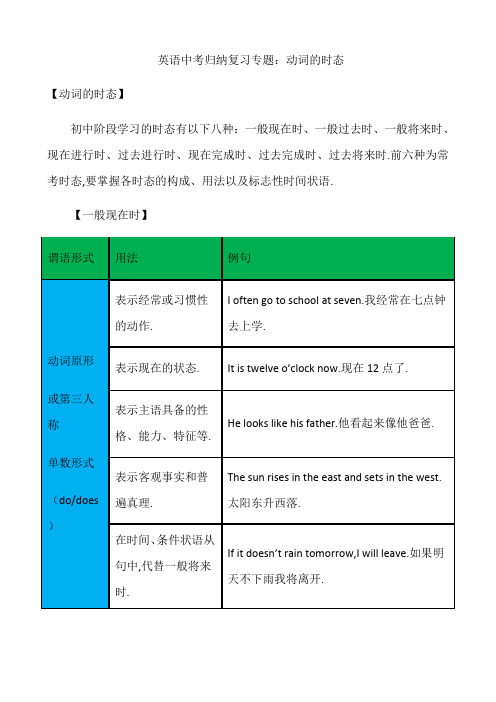
英语中考归纳复习专题:动词的时态【动词的时态】初中阶段学习的时态有以下八种:一般现在时、一般过去时、一般将来时、现在进行时、过去进行时、现在完成时、过去完成时、过去将来时.前六种为常考时态,要掌握各时态的构成、用法以及标志性时间状语.【一般现在时】【考点训练1】1.My father is a teacher and he _________ (teach) in a middle school.2.Yesterday the teacher told us the earth _______ (go) around the sun.3.—When shall we begin our meeting?—We’ll begin it when Helen ___ . ()esB.cameC.will comee4.—How do you usually go to school?—I usually ___ to school on foot. ()A.goB.wentC.was goingD.will go答案:teaches goes A A【一般过去时】要点提醒:“used to+动词原形”表示过去的习惯或状态.如:Mum used to tell us stories.妈妈过去常给我们讲故事.【考点训练2】1.Mike ________ (not go) to bed until 12 o’clock last night.2.He asked if I _____ (be) a student.3.Will you please say it again?I ___ quite ___ you.()A.don’t;hearB.didn’t;hearC.don’t;heardD.didn’t;heard4.He _____ go out with his parents,but now he ____ staying at home alone. ()ed to;is used toB.is used to;used toe to;is used toed to;used to答案:didn’t go was B A【一般将来时】要点提醒:be going to与will的区别1.be going to 指已计划好的事或思考过的意图、打算,will表示未事先思考或未计划而临时做出的决定.如:I’m going to see him tomorrow.我打算明天去看他.(事先经过思考)I’ll answer the door.我去开门.(未经事先考虑)2.be going to可表示客观迹象表明马上要发生的事,而will则表明说话者的主观意愿.如:Look at the clouds.There is going to be a storm.看看这些云,暴风雨就要来了.(客观迹象表明要发生)I hope it will be warm tomorrow.我希望明天会暖和起来.(主观意愿)3.在含有条件状语从句的复合句的主句中,一般用will,不用be going to. 如:I will come if it doesn’t rain.如果不下雨的话,我就来.【考点训练3】1.____ a concert in our school next Saturday. ()A.There isB.There areC.There will beD.There will have2.If they can arrive by 9:00 am,we ___ a meeting.()A.haveB.will haveC.hadD.would have3.He ___ her a beautiful hat on her next birthday.()A.givesB.gaveC.will givingD.is going to give答案:C B D 【现在进行时】【考点训练4】1.They ____________ (have) a math test in the classroom now.2.Look! He ___________ (lie) on the beach.3.—Pass the raincoat to me.It ___ hard now.—Here you are. ()A.rainB.is rainingC.rainedD.will rain4.—Cathy,can you answer the door?I ___ the room.—I’m coming,Mum. ()A.CleanB.cleanedC.have cleanedD.am cleaning答案:are having is lying B D【过去进行时】He was forever com plaining about something.他老是怨这怨那.要点提醒:1.在含有时间状语从句的复合句中,延续时间较长的动作常用过去进行时,另一个短暂性动作用一般过去时.如:When the UFO landed,I was shopping at the clothes store.当UFO落地时,我正在服装店买衣服.2.表示两个延续性动作在过去某一时刻同时进行,不考虑动作的先后顺序,主句和从句的谓语动词都用过去进行时,连词常用while.如:Tom was doing his homework while I was reading a newspaper.我在看报纸时,汤姆在做作业.【考点训练5】1.Mike and I ___________ (play) basketball at that time yesterday afternoon.2.While Mr.Johnson _______________ (work) in the office,the phone rang.3.The girl ___ for the bus when the rainstorm came.()A.waitedB.have waitedC.is waitingD.was waiting4.—Jenny,I called you at nine last night,but you didn’t pick up.—Oh,I ____ a popular program called Go Fighting!.()A.watchB.watchedC.was watchingD.am watching答案:were playing was working D C【现在完成时】要点提醒:1.have/has been to,have/has gone to与have/has been in(考点讲解详见P74考点1)2.延续性动词与非延续性动词英语中的动词按动作发生的方式、发生过程的长短可分为延续性动词和非延续性动词两种,非延续性动词也可称为短暂性动词或瞬间动词.在现在完成时态中,有时要将非延续性动词转换为延续性动词,这样才能和时间段连用.转换方法如下:(1)将短暂性动词转换为“be+形容词或副词”.请看下表:如:这间商店开门6小时了.The shop has opened for 6 hours.( ×)The shop has been open for 6 hours.( √)(2)有的短暂性动词可以转换为意思相同的延续性动词.请看下表:如:这本书我借了一个月了.I have borrowed the book for one month.( ×)I have kept the book for one month.( √)3.现在完成时与一般过去时的区别现在完成时强调某一动作或状态对现在造成的影响或结果,不能和表示过去的时间状语连用;一般过去时只表示过去的事实,不表示和现在的关系,可以和表示过去的时间状语连用.如I bought a ticket yesterday.我昨天买了一张票.(强调我昨天做的一件事是买票)I have already bought a ticket.我已经买了一张票.(强调我已经有票了,无须再惦记票的事了)4.现在完成时的其他句型【考点训练6】1.—you _____ your homework yet?—Yes.I ______ it a moment ago. ()A.Did;do;finishedB.Have;done;finishedC.Have;done;have finishedD.Will;do;finish2.His father ___ the Party since 1978. ()A.joinedB.has joinedC.was inD.has been in3.Miss Green isn’t in the office.She to the library. ()A.has goneB.wentC.will goD.has been 答案:B D A【过去完成时】had + 过去分词表示在过去的过去发生的动作或存在的状态.I had had three pieces of cake when you arrived.你来的时候我已经吃了三块蛋糕了.表示过去某一动作或状态持续到过去另一时间.The old man had lived in Shanghai for ten years beforeTom came here.汤姆来这儿之前,这个老人已经住在上海十年了.时间标志by the time...,before,when等构成的短语或引导的从句【考点训练7】1.在我们到达电影院之前,电影已经开始了.The film __________ before we _______ to the cinema.2.警察赶到时,小偷已经逃跑了.When the police __________,the thief____________________ .答案:had begun got arrived had run away 【过去将来时】【考点训练8】1.李明说如果布莱恩下个月来中国,他将会很高兴.Li Ming said he ___________ happy if Brian came to China the next month.2.蒂娜说她下周三打算来参加我的生日派对.Tina said she ________________ my birthday party the next Wednesday.答案:would be was going to【中考示例】(2017·广西)If he _____ Guilin,he’ll probably go to Yangshuo. ( )A.visitsB.is visitingC.will visitD.has visited【解析】考查动词的时态.句意:如果他游览桂林,他有可能会去阳朔.if引导条件状语从句时,时态遵循“主将从现”原则,从句中用一般现在时表示将来.【考题热身】1.(2017·甘肃)I promise I ________ (send) you an email to explain all of these tomorrow.2.(2017·甘肃)Be quiet! The patients ______________(sleep).3.(2017·鄂州)Sandy’s grandparents__________________ (marry) for 50 years.4.(2017·台州改编)A true friend always ____________(support) you whenever youare in trouble.5.(2017·宿迁)I ______________(wash) the dishes while my sister was sweeping the floor.6.(2017·云南)—What do you think of your hometown, Kate?—It a lot.It’s more beautiful than before. ()A.has changedB.changesC.will changeD.change7.(2017·武汉)—Linda is not coming for the party tonight.—But she ______!()A.promisesB.promisedC.will promiseD.had promised8.(2017·毕节)It’s nice to see you again.We ___ each other since 2016. ()A.won’t seeB.haven’t seenC.don’t seeD.didn’t see9.(2017·黔东南)If it doesn’t rain this weekend,we ___ a picnic in the Jinquan Park. ()A.haveB.will haveC.have hadD.had10.(2017·上海)Some exchange students ___ with their host families this time yesterday. ()A.are chattingB.will chatC.were chattingD.have chatted11.(2017·重庆B卷)—Where is your uncle?I haven’t seen him for a long time. —He _____ Beijing for about half a year.He moved there in January. ()A.has gone to B.has been toC.has arrived inD.has been in12.(2017·重庆B卷)John and I ___ to visit his grandparents last Sunday afternoon. ()A.goB.wentC.will goD.have gone13.(2017·重庆A卷)In the past few years,many schools ____ the ways of doing morning exercises. ()A.changeB.changesC.will changeD.have changed14.(2017·重庆A卷)As soon as the rain _____ ,they will go out to pick apples. ()A.stopsB.stoppedC.will stopD.is stopping15.(2017·河北)Don’t take the dictionary away.I ___ it. ()eedC.am usingD.have used答案:will send are sleeping have been married supports A B BBCDBDAC。
初中英语时态复习材料
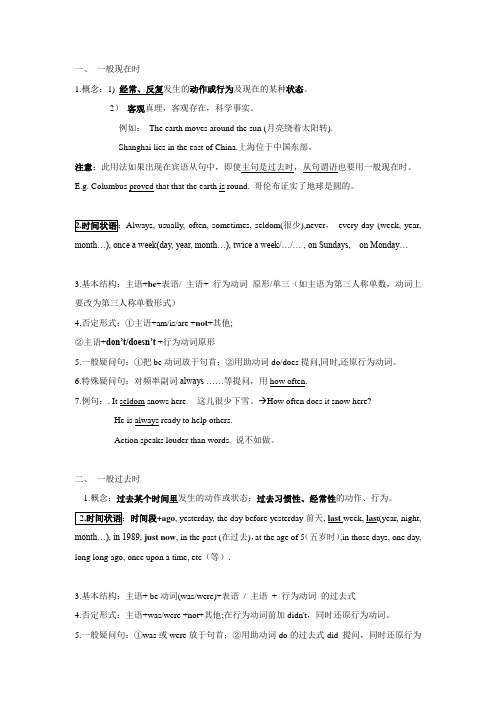
一、一般现在时1.概念:1) 经常、反复发生的动作或行为及现在的某种状态。
2)客观真理,客观存在,科学事实。
例如:The earth moves around the sun (月亮绕着太阳转).Shanghai lies in the east of China.上海位于中国东部。
注意:此用法如果出现在宾语从句中,即使主句是过去时,从句谓语也要用一般现在时。
E.g. Columbus proved that that the earth is round. 哥伦布证实了地球是圆的。
Always, usually, often, sometimes, seldom(很少),never,every day (week, year, month…), once a week(day, year, month…), twice a week/…/… , on Sundays, on Monday…3.基本结构:主语+be+表语/ 主语+ 行为动词原形/单三(如主语为第三人称单数,动词上要改为第三人称单数形式)4.否定形式:①主语+am/is/are +not+其他;②主语+don’t/doesn’t +行为动词原形5.一般疑问句:①把be动词放于句首;②用助动词do/does提问,同时,还原行为动词。
6.特殊疑问句:对频率副词always ……等提问,用how often.7.例句:. It seldom snows here. 这儿很少下雪。
How often does it snow here?He is always ready to help others.Action speaks louder than words. 说不如做。
二、一般过去时1.概念:过去某个时间里发生的动作或状态;过去习惯性、经常性的动作、行为。
时间段+ago, yesterday, the day before yesterday前天, last week, las t(year, night, month…), in 1989, just now, in the past (在过去),at the age of 5(五岁时),in those days, one day, long long ago, once upon a time, etc(等).3.基本结构:主语+ be动词(was/were)+表语/ 主语+ 行为动词的过去式4.否定形式:主语+was/were +not+其他;在行为动词前加didn't,同时还原行为动词。
初中六大时态时态综合复习

初中六大时态目标一:时态区分 目标二:时态互换 目标三:综合训练【目标一:时态区分】 ➢ 中文时态考题经过一个月的努力,我们的法语水平有 很大的提高。
A .过 B.了 C.着 D.的 ➢ 汉译英➢英文主要用谓语动词来表示时间上的变化。
他昨天走了。
他今天走了。
他明天走。
中文是怎么表示时间上的变化? 英文是怎么表示时间上的变化?➢ 英语时态,首先要正确掌握各种时态的形式构成,以work 为例,在对应时态的方框里填入谓语结构。
➢ 然后着重掌握不同时态形式背后的意义表达。
➢各时态用法练一练:单项选择1.Don’t turn on the TV. Grandma ________ now.A. is sleepingB. will sleepC. sleptD. sleeps2.We were in Beijing last week and ________ great fun there.A. will haveB. have hadC. hadD. have3.Hello! Can I speak to Alice? ------ Sorry. She isn’t here right now. She ________ to the shop.A. goesB. will goC. has goneD. was going4.Look! Jane’s grandmother ________ with some aged(老年的)people in the park.A. dancesB. dancedC. is dancingD. was dancing5.Tom ________ to work in his hometown after he graduated(毕业) from university.A. goesB. wentC. will goD. had gone6.________ you ________ the film Harry Potter 5? ------Not yet. I’ll see it this Sunday.A. Did, seeB. Are, seeingC. Have, seenD. Do, see7.The children ________ a P.E. class on the playground(操场)when it suddenly began to rain.A. haveB. are havingC. hadD. were having8.Jim ________ a new camera. He has taken lots of pictures with it.A. buysB. is buyingC. boughtD. will buy9.Please bring your homework to school tomorrow, Steven. ------OK. I ________.A. willB. won’tC. doD. don’t10.How’s Annie? I ________ her for a long time.A. don’t seeB. won’t seeC. didn’t seeD. haven’t seen11.Look! The light is still on in Mr. Zhang’s office. ------I’m afraid he ________ his work yet.A. doesn’t finishB. didn’t finishC. hasn’t finishedD. won’t finish12.What did the teacher say just now? ------Sorry. I didn’t catch it. I ________ something else.A. thinkB. will thinkC. was thinkingD. had thought13.Happiness(幸福)________ in her grandfather’s eyes every time he hears her voice.A. shinesB. is shiningC. has shoneD. was shone14.She ________ the same song so many times. I’m getting sick of it!A. singsB. sangC. will singD. has sung15.Did you see a girl in white pass by just now? ------No, sir. I ________ a newspaper.A. readB. was readingC. would readD. am reading【目标二:时态互换】英语中的几种时态在一定情况下可以互相转换,以下是几种常见的转换形式:➢一般过去时与现在完成时的转换在现在完成时中,延续性动词能与表示一段时间的状语连用,瞬间动词却不能。
初中英语八种时态归纳
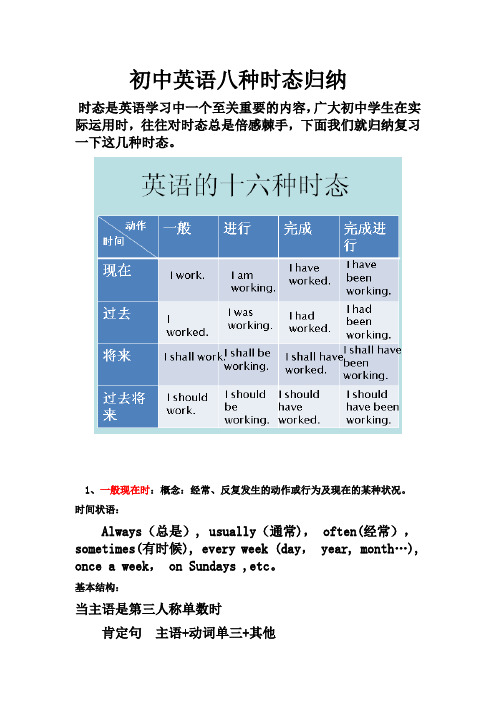
初中英语八种时态归纳时态是英语学习中一个至关重要的内容,广大初中学生在实际运用时,往往对时态总是倍感棘手,下面我们就归纳复习一下这几种时态。
1、一般现在时:概念:经常、反复发生的动作或行为及现在的某种状况。
时间状语:Always(总是), usually(通常), often(经常),sometimes(有时候), every week (day, year, month…), once a week, on Sundays ,etc。
基本结构:当主语是第三人称单数时肯定句主语+动词单三+其他否定句主语+doesn't+动词原形+其他一般疑问句 Does+主语+动词原形+其他肯定回答 Yes,主语+does否定回答 No,主语+doesn’t当主语不是第三人称单数时肯定句主语+动词原形+其他否定句主语+don’t+动词原形+其他一般疑问句 Do+主语+动词原形+其他例句:I never get up early on Sundays.特殊疑问句特殊疑问词(when,where,who,how ,etc.)+一般疑问句2、一般过去时:概念:过去某个时间里发生的动作或状态;过去习惯性、经常性的动作、行为.时间状语:ago, yesterday, the day before yesterday, last week(year,night, month…), in 1989, just now, at the age of 5, one day, long long ago, once upon a time, etc。
基本结构:主语+动词过去式+其他否定形式did+not+do+其他;一般疑问句did+主语+do+其他?例句:I went to Italy 。
I visited museums and sat in public gardens3、现在进行时:概念:表示现阶段或说话时正在进行的动作及行为。
初中英语九种时态归纳复习
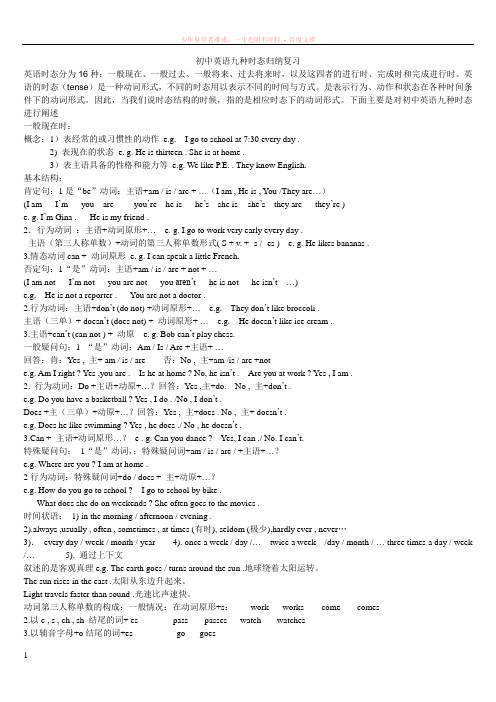
初中英语九种时态归纳复习英语时态分为16种:一般现在、一般过去、一般将来、过去将来时,以及这四者的进行时、完成时和完成进行时。
英语的时态(tense)是一种动词形式,不同的时态用以表示不同的时间与方式。
是表示行为、动作和状态在各种时间条件下的动词形式。
因此,当我们说时态结构的时候,指的是相应时态下的动词形式。
下面主要是对初中英语九种时态进行阐述一般现在时:概念:1)表经常的或习惯性的动作 e.g. I go to school at 7:30 every day .2) 表现在的状态e. g. He is thirteen . She is at home .3)表主语具备的性格和能力等e.g. We like P.E. . They know English.基本结构:肯定句:1是“be”动词:主语+am / is / are + …(I am , He is , You /They are…)(I am --- I’m you are---- you’re he is --- he’s she is -- she’s they are --- they’re )e. g. I’m Gina . He is my friend .2.行为动词:主语+动词原形+… e. g. I go to work very early every day .主语(第三人称单数)+动词的第三人称单数形式( S + v. + -s / -es ) e. g. He likes bananas .3.情态动词can + 动词原形e. g. I can speak a little French.否定句:1“是”动词:主语+am / is / are + not + …(I am not --- I’m not you are not --- you aren’t he is not --- he isn’t …)e.g. He is not a reporter . You are not a doctor .2.行为动词:主语+don’t (do not) +动词原形+… e.g. They don’t like broccoli .主语(三单)+ doesn’t (does not) + 动词原形+ … e.g. He doesn’t like ice cream .3.主语+can’t (can not ) + 动原 e. g. Bob can’t play chess.一般疑问句:1 “是”动词:Am / Is / Are +主语+ …回答:肯:Yes , 主+ am / is / are 否:No , 主+am /is / are +note.g. Am I right ? Yes ,you are . Is he at home ? No, he isn’t . Are you at work ? Yes , I am .2. 行为动词:Do +主语+动原+…?回答:Yes ,主+do. No , 主+don’t .e.g. Do you have a basketball ? Yes , I do . /No , I don’t .Does +主(三单)+动原+…?回答:Yes , 主+does . No , 主+ doesn’t .e.g. Does he like swimming ? Yes , he does ./ No , he doesn’t .3.Can + 主语+动词原形…?e . g. Can you dance ? Yes, I can ./ No. I can’t.特殊疑问句:1“是”动词,:特殊疑问词+am / is / are / +主语+…?e.g. Where are you ? I am at home .2行为动词:特殊疑问词+do / does + 主+动原+…?e.g. How do you go to school ? I go to school by bike .What does she do on weekends ? She often goes to the movies .时间状语:1) in the morning / afternoon / evening .2).always ,usually , often , sometimes , at times (有时), seldom (极少),hardly ever , never…3).every day / week / month / year 4). once a week / day /…twice a week /day / month / … three times a day / week /…5). 通过上下文叙述的是客观真理e.g. The earth goes / turns around the sun .地球绕着太阳运转。
初中英语八种时态归纳复习
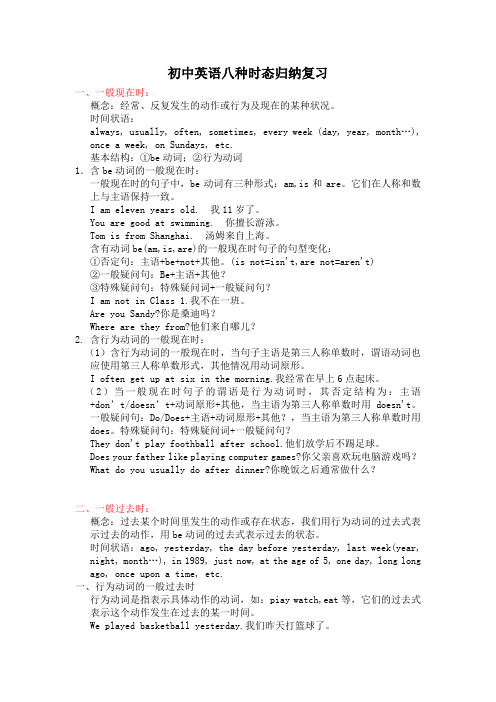
初中英语八种时态归纳复习一、一般现在时:概念:经常、反复发生的动作或行为及现在的某种状况。
时间状语:always, usually, often, sometimes, every week (day, year, month…), once a week, on Sundays, etc.基本结构:①be动词;②行为动词1.含be动词的一般现在时:一般现在时的句子中,be动词有三种形式:am,is和are。
它们在人称和数上与主语保持一致。
I am eleven years old. 我11岁了。
You are good at swimming. 你擅长游泳。
Tom is from Shanghai. 汤姆来自上海。
含有动词be(am,is,are)的一般现在时句子的句型变化:①否定句:主语+be+not+其他。
(is not=isn't,are not=aren't)②一般疑问句:Be+主语+其他?③特殊疑问句:特殊疑问词+一般疑问句?I am not in Class 1.我不在一班。
Are you Sandy?你是桑迪吗?Where are they from?他们来自哪儿?2. 含行为动词的一般现在时:(1)含行为动词的一般现在时,当句子主语是第三人称单数时,谓语动词也应使用第三人称单数形式,其他情况用动词原形。
I often get up at six in the morning.我经常在早上6点起床。
(2)当一般现在时句子的谓语是行为动词时,其否定结构为:主语+d on’t/doesn’t+动词原形+其他,当主语为第三人称单数时用doesn't。
一般疑问句:Do/Does+主语+动词原形+其他?,当主语为第三人称单数时用does。
特殊疑问句:特殊疑问词+一般疑问句?They don't play foothball after school.他们放学后不踢足球。
初中英语八种时态中重要的四种

初中英语八种时态归纳复习,我们挑其中四种详细讲解。
分别为:过去进行时、现在完成时、过去完成时和过去将来时。
一、过去进行时:概念:表示过去某段时间或某一时刻正在发生或进行的行为或动作。
时间状语:at this time yesterday, at that time或以when引导的谓语动词是一般过去时的时间状语等。
基本结构:was/were+doing否定形式:was/were + not + doing.一般疑问句:把was或were放于句首。
例句:1. This time yester day I saw jack ___was repairing__ his bike. So he __ wasn’t watching___ TV then。
a. repaired, didn’t watchb. was repairing, watchedc. repaired, watchedd. was repairing, wasn’t watching2. Lei Feng __was___ always __ thinking___ of others when he ___was___ in the army.a. is, thinking, wasb. was, thinking, isc. did, think, isd. was, thinking, was3. 刚才老师走进教室的时候,同学们正在谈论当天的新闻。
When the teacher came into the classroom just now, the students were talking about to day’s news.4. 上周五一下午,学生们在干什么?他们一直在往墙上贴海报。
What were the students doing the whole afternoon last Friday?They were putting up the posters on the wall.二、现在完成时:概念:过去发生或已经完成的动作对现在造成的影响或结果,或从过去已经开始,持续到现在的动作或状态。
- 1、下载文档前请自行甄别文档内容的完整性,平台不提供额外的编辑、内容补充、找答案等附加服务。
- 2、"仅部分预览"的文档,不可在线预览部分如存在完整性等问题,可反馈申请退款(可完整预览的文档不适用该条件!)。
- 3、如文档侵犯您的权益,请联系客服反馈,我们会尽快为您处理(人工客服工作时间:9:00-18:30)。
关于初中英语时态再复习
学过的英语时态不能忘记,因为,这是基本功,要加强复习和不断的练习。
关于
初中英语时态再复习,希望可以帮到大家
1、一般现在时
概念:经常、反复发生的动作或行为及现在的某种状况。
时间状语:always, usually, often, sometimes, every week (day, year,month…), once a week, on Sundays, etc。
基本结构:①be动词;②行为动词
否定形式:①am/is/are+not;②此时态的谓语动词若为行为动词,则在其前加
don't,如主语为第三人称单数,则用doesn't,同时还原行为动词。
一般疑问句:①把be动词放于句首;②用助动词do提问,如主语为第三人称单数,则用does,同时,还原行为动词。
2、一般过去时
概念:过去某个时间里发生的动作或状态;过去习惯性、经常性的动作、行为。
时间状语:ago, yesterday, the day before yesterday, last week(year,night,month…), in 1989, just now, at the age of 5, one day, long long ago,once upon a time, etc。
否定形式:①was/were+not;②在行为动词前加didn't,同时还原行为动词。
一般疑问句:①was或were放于句首;②用助动词do的过去式did提问,同时还
原行为动词。
3、现在进行时
概念:表示现阶段或说话时正在进行的动作及行为。
时间状语:now, at this time, these days, etc。
基本结构:am/is/are+doing
否定形式:am/is/are+not+doing。
一般疑问句:把be动词放于句首。
4、过去进行时
概念:表示过去某段时间或某一时刻正在发生或进行的行为或动作。
时间状语:at this time yesterday, at that time或以when引导的谓语动词是一
般过去时的时间状语等。
基本结构:was/were+doing
否定形式:was/were + not + doing。
一般疑问句:把was或were放于句首。
5、现在完成时
概念:过去发生或已经完成的动作对现在造成的影响或结果,或从过去已经开始,持续到现在的动作或状态。
时间状语:recently, lately,since…for…,in the past few years, etc。
基本结构:have/has + done
否定形式:have/has + not +done。
一般疑问句:have或has。
6、过去完成时
概念:以过去某个时间为标准,在此以前发生的动作或行为,或在过去某动作之
前完成的行为,即“过去的过去”。
时间状语:before, by the end of last year(term,month…),etc。
基本结构:had + done。
否定形式:had + not + done。
一般疑问句:had放于句首。
7、一般将来时
概念:表示将要发生的动作或存在的状态及打算、计划或准备做某事。
时间状语:tomorrow, next day(week, month,year…),soon, in a few minutes,by…,the day after tomorrow, etc。
基本结构:①am/is/are/going to + do;②will/shall + do。
否定形式:①am/is/are + not+ going to + do; ②在行为动词前加will /shall+
not+do,同时还原行为动词。
一般疑问句:①be放于句首;②will/shall提到句首。
8、过去将来时
概念:立足于过去某一时刻,从过去看将来,常用于宾语从句中。
时间状语:the next day(morning,year…),the following month(week…),etc。
基本结构:①was/were/going to + do;②would/should + do。
否定形式:①was/were/not + going to + do;②would/should + not + do。
一般疑问句:①was或were放于句首;②would/should 提到句首。
其实,这些时态在一定情况下是可以互相转换的……
1、一般过去时与现在完成时的转换
在现在完成时中,延续性动词能与表示一段时间的状语连用,瞬间动词却不能。
但是,可用別的表达方式:
①瞬间动词用于“一段时间+ ago”的一般过去时的句型中;
②瞬间动词可改成与之相对应的延续性动词及短语,与一段时间连用;
③瞬间动词用于“It is + 一段时间 + since + 一般过去时”的句型中,表示“自从……
以来有……时间”的意思,主句一般用it is来代替It has been;
④瞬间动词用于“Some time has passed since + 一般过去时”的句型中。
请看:
A、He joined the League two years ago。
B、He has been in the League for two years。
C、It is two years since he joined the League。
D、Two years has passed since he joined the League。
2、一般现在时与现在进行时的转换
在一般现在时中,at加上名词表示“处于某种状态”,如at work(在工作), at school(上学、上课)等。
此短语可与进行时态转换。
请看:
Peter is at work, but Mike is at play。
Peter is working, but Mike is playing。
3、现在进行时与一般将来时的转化换
在现在进行时态中go, come, leave, start, arrive等动词常与表示将来的时
间状语连用表示将要发生的动作。
如:I am coming, Mum! 意为“我就来,妈妈!”请看:The train is leaving soon。
The train will leave soon。
4、“be going to+动词原形”与“will(shall)+动词原形”结构的转换
“be going to+动词原形”、表示打算、计划要做的事;将来时“will(shall)+动词原形”结构在书面语中,当主语为第一人称时,常用助动词shall。
在口语中,所有人称都可以用will。
请看:
We are going to visit the Great Wall next Sunday。
We shall visit the Great Wall next Sunday。
